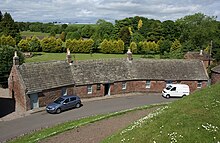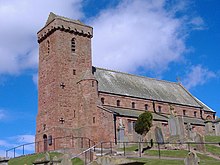St Vigeans Museum
The museum of St Vigeans in the Scottish County Angus houses cross-slabs , gravestones and Pictish symbols . In total there are 38, more or less fragmentary stones.
St. Vigeans is a small village one mile on the northern edge of Arbroath . Old St. Vigeans was a single street that wound around the base of the church hill. The church, founded around 1242, is built from red sandstone , just like the Kirkstyle Cottages around the church . Two of them were transformed into the St. Vigean's "Museum of Carved Stones", which reopened in 2009. It is home to a collection of carved stones from the Pictish times (6th and 7th centuries) and from early Christian times. The stones and tombstones seem to have been collected around the site and used in the construction of the new church. During the renovation and expansion of the church in 1871, the stones were detached from the wall and placed in the anteroom. They stayed there until 1960, when the collection came into the hands of Historic Scotland and was moved to the Kirkstyle Cottages.
The history of St. Vigeans began in the 8th century with the founding of the monastery named after Saint Feichín. The name of the Irish saint, who died in 664, is sometimes rendered in Latin as St. Vigeanus. The importance of the monastery of St. Vigeans, if it still existed at all, waned when the Scottish King William I (1143-1214) founded an abbey in Arbroath.
Five of the stones show those symbols that are usually found on Pictish symbol stones. Nine are former tombstones or parts of them. Eight stones show saints, including Antony and Paul at the Lord's Supper . Five of the stones were apparently carved at the same time. They represent a group commissioned by a patron and destined for the new St. Vigeans Church. Eight other stones are architectural fragments of the oldest church, which was built in the 1100s.
Drosten-Stone
The highlight of the collection is the so-called “Drosten Stone”, a cross-slab 182 cm high and 53 cm wide. It is believed that he used to stand at the entrance to St. Vigeans Monastery. At some point it was broken into three parts. A smaller center piece is still missing. The front view of the Drosten stone bears a long cross, which is laid out with a knot pattern and is surrounded by fantastic creatures and demons. The back of the stone bears a mixture of Pictish symbols and animal figures. Two dogs chase a deer, while an archer kills a boar. Carvings of a bear, a unicorn, a fawn with doe and a bird are also available. The peculiarity of the stone is an inscription: "Drosten IRE UORET ETT forcus". It could mean "Drosten, in the reign of Uoret and Forcus," but opinions differ.
But not all of the stones found around the church have been taken to the museum. Some gravestones along the cemetery wall are qualitative, especially the one from 1746.
literature
- Thomas Owen Clancy, (1993), "The Drosten Stone: a new reading" (PDF), Proceedings of the Society of Antiquaries of Scotland, 123: 1993 pp. 345-353
Web links
- [1] Pictures from and around the museum
- Canmore description engl. and pictures
Coordinates: 56 ° 34 ′ 37.3 " N , 2 ° 35 ′ 25" W.



